SUBJECTS
GRADE
Show Results
Our National Anthem: A "Whole Language" Experience
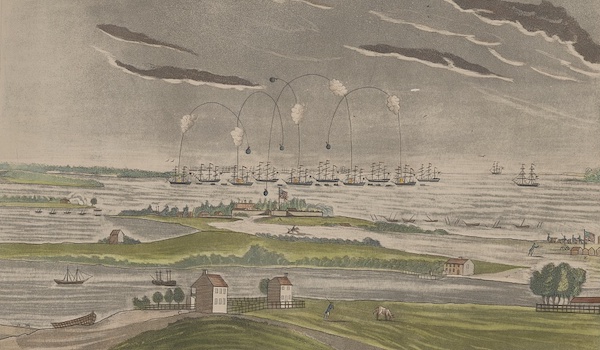
Lesson Summary
- Explore background information about the national anthem.
- Learn to sing the national anthem.
- Focus on words, rhythm, and/or melody.
Lesson Plan and Procedure
Lesson Key Facts
- Grade(s): 2, 3, 4, 5, 6
- Subject(s): Drama, English Language Arts, Music, Social Studies, Visual Arts
- Duration of lesson: One to three sessions, 30-45 minutes each
- Author(s): Susan Kenney
NOTE: Several teachers have asked for ideas to help teach "The Star-Spangled Banner." This lesson suggests ways of using our national anthem throughout the curriculum.
"The Star-Spangled Banner" is challenging for students to learn because the lyrics use words and concepts unfamiliar to students' experiences and because the melody has wide jumps upward and downward. But this challenge offers an opportunity to help students increase their vocabulary, learn more about the history of their country, and develop greater musical understanding.
Before teaching the song, provide some background information and activities that will help students experience vicariously the events surrounding the writing of the words. Several introductory possibilities are suggested. You may think of others.
Introductory Possibilities
Tell the Story
Tell how "The Star-Spangled Banner" came to be written. Refer to sources online or a book on the subject in the library. One child-friendly book with written story and lovely pictures is The Story of the Star-Spangled Banner by Natalie Miller.
Play Vocabulary Game
Create two sets of cards (see "Equipment and Materials Needed") for each student or group of students. The students should match each card in set one with the appropriate definition in set two. Students may use dictionaries to assist them.
When students know the words, create two teams. Select a scorekeeper and a leader. The leader gives a word from the white card to team one. If answered correctly, team one gets a point. If not, team two has a chance to answer. If no one can answer, no point is given. The next word is given to team two, and so on. The teams may have their deck of cards for reference, but the cards should be mixed up.
Draw the Story
Invite students to draw different scenes from the story. Put the drawings together, in order, and tell the story with pictures. The pictures could be taped together to make an accordion book display, or they could be glued to a long strip and made into a roller box display. A link to a site that describes how to make a roller box can be found here: http://www.reading-with-kids.com/roller-box.html.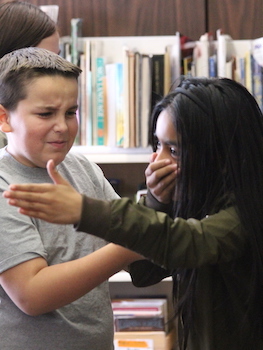 Consider helping the students make scenery for the dramatization of the story. Study history books, maps, and internet resources so the scenery will be as accurate as possible.
Consider helping the students make scenery for the dramatization of the story. Study history books, maps, and internet resources so the scenery will be as accurate as possible.
Make a large mural of the story. The mural might illustrate the night on the boat and the morning when the flag was still there.
Dramatize the Story
The script (see "Equipment and Materials Needed") provides ideas for acting out the story of how "The Star-Spangled Banner" came to be written. Several versions of the story exist, and historians are not sure of all of the facts. The source used to write this script is from the Library of Congress. This script is written from "The Star-Spangled Banner" by Oscar George Theodore Sonneck, chief of the Division of Music (Library of Congress, Washington: Government Printing Office, 1914).
Learning The Song
Focusing on the Words
One way to teach a song is to have students listen while you sing, asking them to discover answers to questions you ask about the words. The purpose is two-fold:
- To challenge students to think.
- To encourage students to listen.
Remember, students first learn a song by hearing it, and they need to hear it several times before singing it.
Select which of the following teaching ideas will work for you and your students. Remember to sing the song each time you ask a question, so students hear the song many times.
Teacher: Francis Scott Key wrote a poem about his experience while he was being held prisoner on a British boat. He used many unusual words in his poem. For example, near the end of the first verse, he referred to the United States but used different words. What are the words he used? ("Land of the free and home of the brave").
The melody emphasizes "land of the free" by moving up the scale ("loo" the melody on the words). When it comes down, end the song on the word "brave." Invite students to sing the phrase, being careful to sing "free" on pitch.
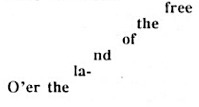
Teacher: What words did Mr. Key use to mean "early in the morning"? ("Dawn's early light.") And to mean "evening"? ("Twilight's last gleaming.") The lowest sound in the song occurs on which one of those six words? ("Gleaming.")
The melody on the word "early" also goes quite low. Invite students to sing about the dawn and the twilight, listening to make sure they sing the low notes correctly.
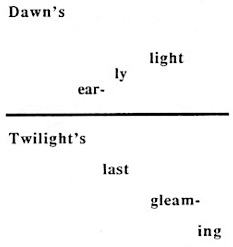
Teacher: Did Mr. Key write this poem in the evening or the morning? ("Morning, dawn.")
Teacher: Mr. Key referred to the flag at least five times in this song, but he used the word "flag" only once. What other words did he use that referred to the flag? (Something "we proudly hailed," "broad stripes" and "bright stars," something "gallantly streaming," and the "star-spangled banner.")
Teacher: The flag was inside Fort McHenry, but it was high above the fort walls and barricades. The light from the rockets made it possible to see the flag. What was the barricade called "o'er" which they watched? ("Ramparts.") The word "ramparts" is emphasized by a high jump in the melody. Try to sing that musical jump accurately ("o'er the ramparts we watched").
Teacher: The flag is described using the words "stripes" and "stars." What words does he use to describe the stripes and the stars? ("Broad, bright.") Sing that phrase, articulating the words carefully. It's almost a tongue twister.
Teacher: Sometimes we say the flag is flying in the breeze. This song says it is "streaming," instead of flying. What word in the song is used to describe how it is streaming? Hint: The way it is streaming is very proudly and bravely. ("Gallantly.")
Teacher: Mr. Key and his friends could tell the flag was still flying, even in the middle of the night. What words in the song suggest the way they were able to tell the flag was still flying? ("The rockets' red glare," "bombs bursting in air.")
The idea of the rockets and bombs exploding high in the air is emphasized by the high melody in this part of the song. This is the most difficult part of the song to sing, so students will need to take a good breath, sit very tall, and listen to themselves. Invite the students to imagine the rockets and bombs bursting in the middle of the night up high in the sky as they sing the high melody.
Focusing on the Rhythm
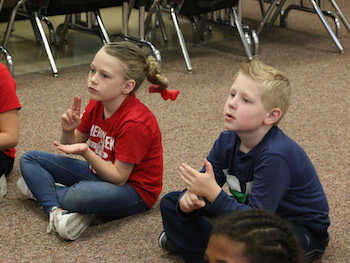 When focusing on the rhythm, students have an opportunity to move to the song and learn about beats and rhythm patterns while learning to sing.
When focusing on the rhythm, students have an opportunity to move to the song and learn about beats and rhythm patterns while learning to sing.
Invite students to quietly tap the beat. Use two fingers of one hand to tap the palm of the other hand while the teacher sings.

Teacher: Try patting the strong beat on your lap and tapping the weak beats on your hand.
Strong weak weak Strong weak weak
(lap hand hand lap hand hand)

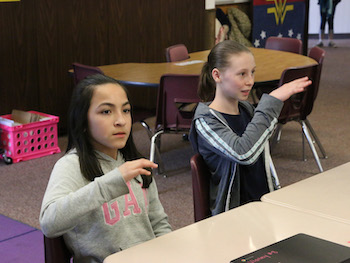 This song has a meter of three. Teach the students to conduct the song while singing. Bring the hand straight down in front of the body on beat one, away from body on beat two, and toward body on beat three, making a triangle shape, as illustrated.
This song has a meter of three. Teach the students to conduct the song while singing. Bring the hand straight down in front of the body on beat one, away from body on beat two, and toward body on beat three, making a triangle shape, as illustrated.
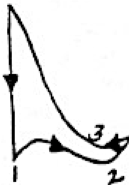
Teacher: Clap on the strong beat, and feel the weak beats without clapping them.
NOTE: The following ideas are JUST FOR FUN! Do not expect the students to master the activities; just enjoy the challenge while singing the song over and over.
Teacher: "Catch" each word that occurs on the strong beat by singing only strong-beat words while you sing the whole song.
Students sing only when they pat their laps, not when they tap their hands.

Teacher: Try to sing everything except the syllables that occur on the strong beat.
Students would sing this:
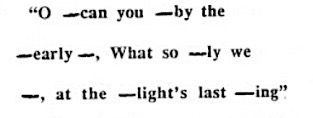
Try dividing the class into two groups. Group two sings only the words that occur on the strong beat, and group one sings the words that occur on the weak beat. In other words, group two sings when the hands touch the lap. Group two sings everything else. Enjoy!
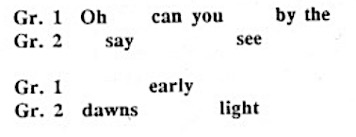
Focusing on the Melody
When focusing on the melody, attention is drawn to repeated phrases, high and low melodic patterns, and other melodic events in the song. The students learn the song while learning about the music. Make large copies of charts one to five (see section "Equipment and Materials Needed") to assist in teaching melodic ideas.
"Loo" the melody of the first five words ("oh say can you see"), and show chart one.
Teacher: What words occur on this melody? ("Oh say can you see." If students only respond with those first five words, tell them that this melody occurs more than once.) What other words occur in this melody? ("Whose broad stripes and bright stars.")
Invite students to sing only those two parts aloud while you sing the rest of the song.
"Loo" the melody of "what so proudly we hailed" (also "o'er the ramparts we watched"), and show chart two. Ask students to identify words that occur in this pattern and then sing them.
Divide the students into five groups. Give each group one of the five charts, and assign them to sing when their part comes in the song.
- Chart 1: "O say can you see" and "whose broad stripes and bright stars"

- Chart 2: "By the dawn's early light" and "through the perilous fight"

- Chart 3: "What so proudly we hailed" and "o'er the ramparts we watched"

- Chart 4: "At the twilight's last gleaming" and "were so gallantly streaming"

- Chart 5: "And the rocket's red glare, the bombs bursting in air, gave proof through the night that our flag was still there".
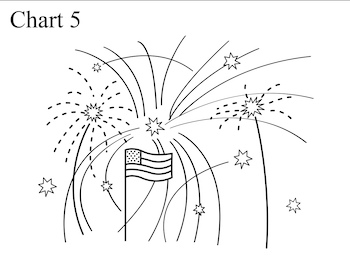
- Everyone joins on "Oh, say, does that Star-Spangled Banner yet wave" to the end of the song, as someone holds up the flag.
Place the following words on the board:
Oh, say, does that Star-Spangled Banner yet wave
O'er the land of the free and the home of the brave?
Sing the words, asking students to identify which syllables have more than one pitch. As the students discover the answers, place two dots over each syllable with two pitches, and one dot over syllables with one pitch, as illustrated.
Invite students to sing, taking care to give each syllable the correct number of pitches.
As an added challenge, students may enjoy making the pitches higher or lower to match the melodic direction. Slurs may be added to show which syllables have two tones.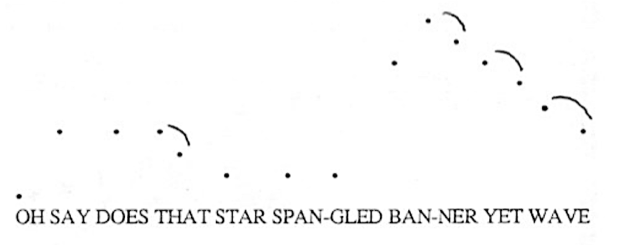
Final note: This song is an important part of our history. Take time to help students learn the song and its meaning. As you teach them to sing, provide opportunity for them to think, listen, solve problems, and learn about the music. Whole-language teaching at its best!
Learning Objectives
- Discover the history connected with the national anthem.
- Understand the meaning of the words in our national anthem.
- Sing the national anthem in tune.
- Respond to visual representations of melodic and rhythmic patterns.
- Perform rhythm patterns in three-meter.
- Experience patriotic music that connects us to our history.
- Quote accurately from lyrics in response to questions.
- Understand vocabulary found in the national anthem.
- Perform a historical play depicting the setting in which the national anthem was written.
- Create artwork depicting the setting in which the national anthem was written.
Utah State Board of Education Standards
This lesson can be used to meet standards in many grades and subject areas. We will highlight one grade’s standards to give an example of application.
Grade 5 Social Studies
- Standard 5.3.6: Describe the civic duties members of American society have today (for example, voting, holding public office, jury duty).
Grade 5 English Language Arts
- Standard 5.R.5: Identify and refer to evidence from a text when explaining what the text says explicitly and when drawing inferences from the text. (RL & RI)
- Standard 5.R.8: Determine the meaning of words, phrases, figurative language, academic and content-specific words, and analyze their effect on meaning within a text. (RL & RI)
- Standard 5.R.9: Determine or clarify the meaning of unknown and multiple-meaning words and phrases, choosing flexibly from a range of strategies. (RL & RI)
Grade 5 Drama
- Standard 5.T.CR.2: Arrange the physical playing space to communicate mood, time, and locale.
- Standard 5.T.CR.5: Create character through physical movement, gesture, sound and/or speech and facial expression with age-appropriate outcomes.
- Standard 5.T.P.2: Perform as a productive and responsible member of an acting ensemble in both rehearsal and performance situations.
- Standard 5.T.P.3: Observe, listen, and respond in character to other actors throughout a scripted or improvised scene.
- Standard 5.T.P.4: Communicate meaning using the body through space, shape, energy, and gesture.
- Standard 5.T.P.5: Communicate meaning using the voice through volume, pitch, tone, rate, and clarity.
- Standard 5.T.P.7: Select materials to be used for scenery, properties, costumes, lighting, and sound effects for informal classroom presentations.
- Standard 5.T.CO.2: Read plays and stories from a variety of cultures and historical periods and identify the characters, setting, plot, theme, and conflict to better understand performance and design choices.
Grade 5 Music
- Standard 5.M.P.5: Respond to visual representations of melodic patterns using pentatonic and diatonic scales.
- Standard 5.M.P.7: Perform and identify rhythm patterns in two-, three-, and four-beat meters using body percussion, voice, and simple instruments.
- Standard 5.M.P.8: Respond with body percussion, voice, or simple instruments to visual representations of rhythm patterns.
- Standard 5.M.CO.3: Deepen understanding of another content area through music.
- Standard 5.M.CO.4: Experience and explore music which connects us to history, culture, heritage, and community.
Grade 5 Visual Arts
- Standard 5.V.C.1: Combine ideas to generate an innovative idea for art-making.
- Standard 5.V.R.2: Identify and analyze cultural associations suggested by visual imagery.
Equipment and Materials Needed
- Miller, Natalie, and George Wilde.The Story of the Star-Spangled Banner. Chicago: Childrens Press, 1965. (Optional) Other picture books could be used instead
- "The Star-Spangled Banner" sheet music (PDF)
- "The Star-Spangled Banner" vocabulary card sets (PDF)
- Arts supplies
- "The Star-Spangled Banner": a play in six scenes (PDF)
- "The Star-Spangled Banner" melodic charts 1–5 (PDF)
- White board/interactive board to dot rhythms above written lyrics
- Slides 12-13 in PowerPoint: “Folk Songs from U.S. History”
Additional Resources
- Instructions for how to make a roller box suggested as an introductory possibility can be found at http://www.reading-with-kids.com/roller-box.html.
- YouTube video depicting the history behind the writing of the national anthem: https://www.youtube.com/watch?v=Umg8v6DLZjs.
- Information about and a picture of Fort McHenry: https://www.nps.gov/places/star-spangled-banner.htm.
Image References
- Image 1: https://www.loc.gov/pictures/item/2013645001/
- Images 2–11: Susan Kenney.
- Images 12–16: Curtis Soderborg.
- Images 17–18: Susan Kenney.

www.education.byu.edu/arts/lessons
 Download
Download